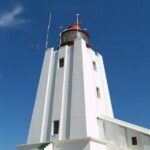Cape Colombine lighthouse
Cape Columbine Lighthouse was constructed only in 1936. The lighthouse stands on a massive granite boulder called Castle Rock. It was the last manned lighthouse constructed in the country and the last significant project of the famed Harry Claude Cooper.
For many years it was accepted that a lighthouse here was essential, however, construction was delayed for several reasons, particularly the urgency of the need for lighthouses in other areas. The design is unconventional. It was also the first lighthouse to receive all three navigational safety features, i.e., a light, a fog signal, and a radio beacon. The optical apparatus, supplied by Messrs Chance Brothers, was the first lens system designed for use with a 4kW incandescent electric lamp on the South African Coast. All prior installations had been designed for wick or petroleum vapor burners
.It has a candlepower of 5 040 000 which flashes every 5 seconds It can be seen for 30 nautical miles from its 15-metre white square masonry tower with red painted lantern house.
The lighthouse rests on a windswept coastline within the Columbine Nature Reserve. The sea is hazardous here with submerged rocks including the Britannia Reef and Soldiers Reef and there have been numerous shipwrecks in the past including the Columbine, which was wrecked in 1829, 1.5 km north of the lighthouse. the Heleric (1932), the Haddon Hall (1913), the Lisboa (1910) and the In 1876 the iron steam troopship SS Saint Lawrence was wrecked on Great Paternoster Point. Bound for Cape Town. She was carrying the 2nd Battalion of the 3rd Buffs. Fortunately, no lives were lost.
Urban legend tells of the SS Lisboa which was laden with a large quantity of red wine, the wine from shattered barrels stained the sea. Fortunately, a large number of undamaged barrels were washed ashore and were buried by the locals to be retrieved much later after the customs officials had left! The name Colombine is from the barque Colombine which was wrecked in 1829.
The Cape Columbine Lighthouse is usually the first South African lighthouse to be seen by ships traveling from Europe.
32° 49′ 39.932″ S, 17° 51′ 20.178″ E


